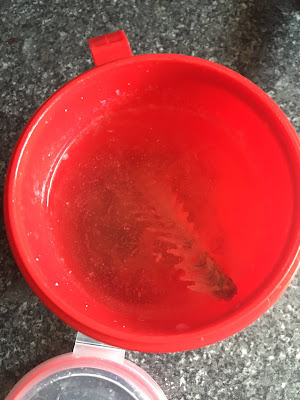Adventures in fish bone preparation
 |
| Cold water maceration |
Nonetheless, in order to do this, I needed some specimens! Luckily Newcastle is attached to the Hancock Museum who were kind enough to lend us some birds and small mammals. But after doing the Sheffield module what I really wanted to include were fish bones! There is an amazing virtual fish bone resource at Nottingham, but there's nothing like handling the real thing, and I happened to notice the fish counter at Tesco sells whole fish. So following a meal of grilled sea bass, I undertook a cold water maceration preparation method, placing the bones in a soup container with water and a tiny amount of washing powder. I kept the vent open on the lid, and left them on the kitchen windowsill for 3 weeks. After 3 weeks I decanted the water, and the majority of the flesh had dissolved away. Admittedly it smelt terrible, but not actually as bad as I thought it would be. I added fresh water, a bit more washing powder, and left them for another week before decanting again and rinsing about 10 times to get rid of any remaining residue and washing powder. I left them to dry on paper towels overnight and voila, beautiful clean fish bones!
For the class activity I set up the computers with the Archaeological Fish Resource website, and got the students to find the species we were looking at (Dicentrarchus labrax). Then we tried to identify the skull bones by comparing them with the website reference specimen. It went really well, some of the students even suggested they should get to prepare their own specimens as part of the module! Next on the list is a pigeon that I found on the side of the road. Currently undergoing an initial stage of open air decomposition under a plant pot in the back of the garden, I'll be transferring him to a container in the next week...
 |
| One whole sea bass, fully defleshed and drying |

Comments
Post a Comment